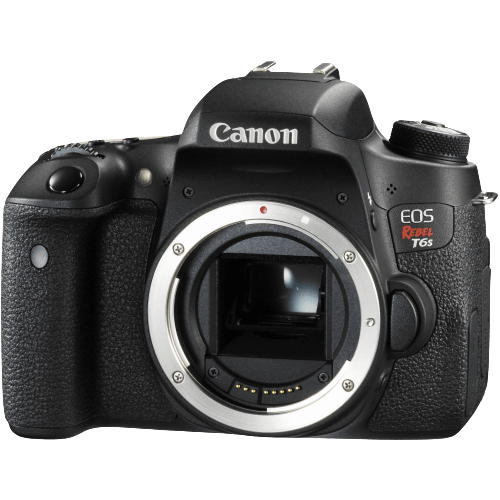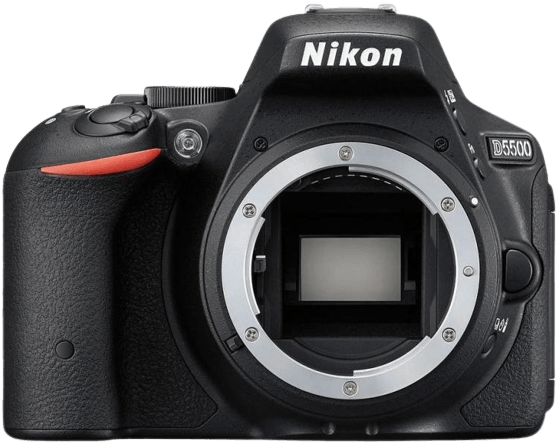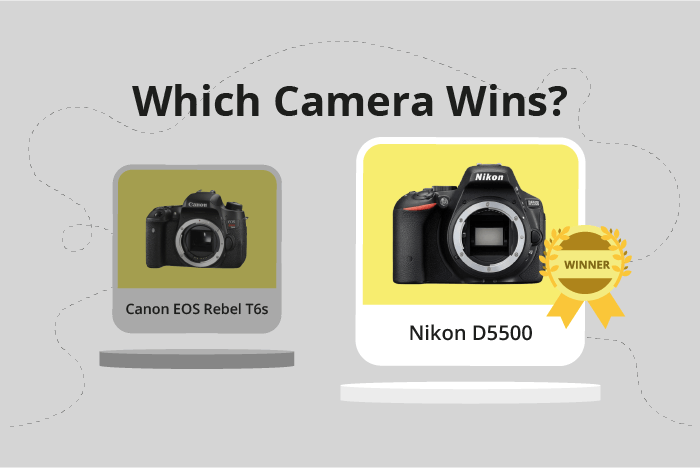Canon EOS Rebel T6s / 760D vs Nikon D5500 Comparison
Canon EOS Rebel T6s / 760D

Nikon D5500

The Nikon D5500 emerges as the winner with a score of 61/100, while the Canon EOS Rebel T6s / 760D trails behind with a score of 56/100. Both cameras are DSLRs released in 2015, with the Nikon D5500 priced at $900 and the Canon EOS Rebel T6s / 760D at $850. They share similar specifications, but there are some differences that set them apart.
The Canon EOS Rebel T6s / 760D has a larger size (132 x 111 x 78mm) and is heavier (565g / 1.25lbs) compared to the Nikon D5500 (124 x 97 x 70mm and 420g / 0.93lbs). This makes the Nikon D5500 more compact and lighter, which can be an advantage for photographers who value portability.
On the other hand, the Canon EOS Rebel T6s / 760D has its own strengths, but it falls short in comparison to the Nikon D5500. Thus, the Nikon D5500 stands as a better choice due to its higher score, compact size, and lightweight design.
Canon EOS Rebel T6s / 760D vs Nikon D5500 Overview and Optics
The Nikon D5500 outperforms the Canon EOS Rebel T6s / 760D in terms of optics, scoring 65/100 compared to the Canon’s 59/100. Both cameras share several specifications, such as 24.2 megapixels, a shooting speed of 5, CMOS sensor type, APS-C sensor size, and lack of image stabilization. Despite these similarities, there are distinct advantages to each camera.
The Nikon D5500 boasts a superior DXOMARK sensor score of 84, compared to the Canon T6s’s score of 70. This difference indicates better overall image quality and low-light performance. Additionally, the Nikon D5500 features the Nikon F DX lens mount, which offers a wide range of compatible lenses. This versatility allows users to explore various shooting styles and adapt to different situations with ease.
On the other hand, the Canon T6s has the advantage of a more advanced processor, the Digic 6, as opposed to the Nikon’s Expeed 4. This higher-end processor enables faster processing of images and improved performance in certain situations, such as continuous shooting. The Canon T6s also features the Canon EF-S lens mount, providing compatibility with a variety of Canon lenses.
While both cameras offer strong optics, the Nikon D5500’s higher DXOMARK sensor score and versatile lens mount give it an edge over the Canon T6s. However, the Canon T6s’s advanced processor should not be overlooked, as it can provide better performance in specific shooting scenarios. Ultimately, the choice between these two cameras will depend on individual preferences and requirements, but the Nikon D5500 holds a slight advantage in terms of optics.
Canon EOS Rebel T6s / 760D vs Nikon D5500 Video Performance
The Nikon D5500 outperforms the Canon EOS Rebel T6s / 760D in video capabilities with a score of 70/100 compared to 43/100. Both cameras have Full HD video resolution and maximum video dimensions of 1920 x 1080. Despite these similarities, the Nikon D5500 surpasses the Canon T6s in terms of video performance.
The winning aspect of the Nikon D5500 lies in its higher maximum video frame rate of 60fps, double that of the Canon T6s, which only offers 30fps. This higher frame rate allows for smoother video playback and better slow-motion capabilities. Additionally, the Nikon D5500 has built-in time-lapse functionality, providing users with a creative feature for capturing stunning time-lapse videos without needing external accessories or software.
Although the Canon T6s lags behind its competitor in video performance, it still offers a respectable Full HD video resolution and 30fps frame rate, suitable for casual video shooting and beginner filmmakers. However, it lacks the advanced video capabilities and features found in the Nikon D5500.
Based on these comparisons, the Nikon D5500 stands out as the superior camera for video capabilities, offering a higher frame rate and built-in time-lapse functionality. The Canon T6s, while not as advanced, still provides decent video quality for casual users. When considering video performance, the Nikon D5500 is the clear winner between the two cameras.
Canon EOS Rebel T6s / 760D vs Nikon D5500 Features and Benefits
The Nikon D5500 wins the features comparison with a score of 59/100, while the Canon EOS Rebel T6s / 760D scores slightly lower at 57/100. Both cameras share several key features, including a touchscreen, flip screen, Wi-Fi connectivity, and the absence of GPS and Bluetooth capabilities.
The Nikon D5500 has an advantage in screen size and resolution, boasting a 3.2-inch screen with a resolution of 1,037,000 dots. This larger screen provides a more enjoyable and detailed viewing experience when composing shots and reviewing images. Additionally, the D5500’s marginally higher feature score indicates that it offers a slightly broader range of options for photographers to utilize in various shooting situations.
On the other hand, the Canon EOS Rebel T6s / 760D does not lag far behind, with a 3-inch screen and a resolution of 1,040,000 dots. The difference in screen size and resolution between the two cameras is minimal and may not be a deciding factor for some users. The T6s / 760D’s feature score, although lower than the D5500’s, still demonstrates that it is a capable camera with a range of features to suit different photography needs.
Given the close scores and shared specifications, the choice between the Nikon D5500 and Canon EOS Rebel T6s / 760D will likely depend on personal preferences and brand loyalty. Both cameras offer a solid range of features for photographers, with the D5500 having a slight edge in screen size and resolution. However, the T6s / 760D remains a strong contender, providing a near-equivalent user experience and feature set.
Canon EOS Rebel T6s / 760D vs Nikon D5500 Storage and Battery
The Nikon D5500 outperforms the Canon EOS Rebel T6s / 760D in storage and battery with a score of 35/100 compared to the Canon’s 24/100. Both cameras have one memory card slot and accept SD, SDHC, and SDXC cards. Neither camera supports USB charging.
The Nikon D5500 excels with a battery life of 820 shots, significantly more than the Canon’s 440 shots. The D5500 uses an EN-EL14 battery type, while the T6s / 760D uses an LP-E17 battery type. The longer battery life makes the Nikon D5500 a more reliable option for extended shooting sessions.
The Canon T6s / 760D does not have any advantages in storage and battery over the Nikon D5500. The Nikon D5500’s superior battery life and equal storage capabilities make it the better choice in this category.
Alternatives to the Canon EOS Rebel T6s / 760D and Nikon D5500
Are you still undecided about which camera is right for you? Have a look at these popular comparisons that feature the Canon EOS Rebel T6s / 760D or the Nikon D5500:

